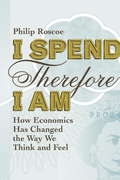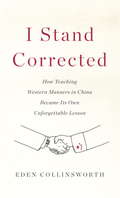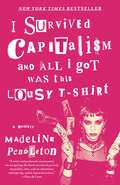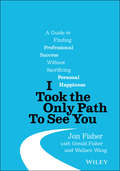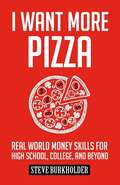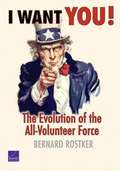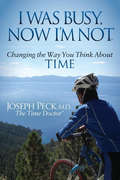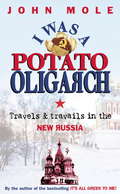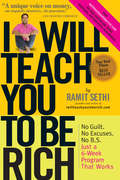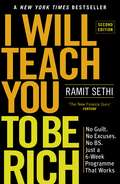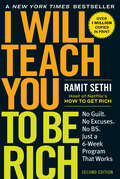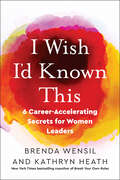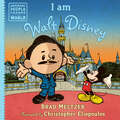- Table View
- List View
I Spend Therefore I Am
by Philip RoscoeA powerful exploration of how economic thinking has infiltrated every aspect of modern life, even our understanding of who we are and what it means to be a person. Economics is the academic success story of the 20th century, a potent force not just in markets and government, but in our everyday lives. It affects our decisions as consumers, of course, but also our education, our health, our social lives and our family relationships. In his trenchant book, Philip Roscoe argues that the justifications of economics allow us to set aside social or moral obligations and to act instead within a limited, short-term definition of self-interest. This attitude, and these justifications, are responsible for the gravest problems we face, from global financial meltdown to environmental threat. I Spend Therefore I Am shows how our daily activities, our values, and even our understanding of what it is to be a person have been changed for the worse by economics, a discipline, he writes, "at war with the goods of life."
I Stand Corrected
by Eden CollinsworthA fascinating fusion of memoir, manners, and cultural history from a successful businesswoman well versed in the unique challenges of working in contemporary China.During the course of a career that has, quite literarily, moved her around the world, no country has fascinated Eden Collinsworth more than China, where she has borne witness to its profound transformation. After numerous experiences there that might best be called "unusual" by Western standards, she concluded that despite China's growing status as a world economy, businessmen in mainland China were fundamentally uncomfortable in the company of their Western counterparts. This realization spawned an idea to work collaboratively with a major Chinese publisher on a Western etiquette guide, which went on to became a bestseller and prompted a branch of China's Ministry of Education to suggest that she create a curriculum for the school system. In I Stand Corrected, Collinsworth tells the entertaining and insightful story of the year she spent living among the Chinese while writing a book featuring advice on such topics as the non-negotiable issue of personal hygiene, the rules of the handshake, and making sense of foreigners. Scrutinizing the kind of etiquette that has guided her own business career, one which has unfolded in predominately male company, Collinsworth creates a counterpart that explains Chinese practices and reveals much about our own Western culture. At the same time, I Stand Corrected is a wry but self-effacing reflection on the peripatetic career she led while single-handedly raising her son, and here she details the often madcap attempts to strike a balance that was right for them both.
I Survived Capitalism and All I Got Was This Lousy T-Shirt: Everything I Wish I Never Had to Learn About Money
by Madeline PendletonNEW YORK TIMES BESTSELLER • A big-hearted, no-bullshit memoir from the TikTok superstar about her journey from living paycheck to paycheck to creating a multi-million-dollar business that offers a compassionate alternative to capitalism • Includes no-nonsense life and money advice, from negotiating pay and building credit to putting home ownership within reach"Madeline's life is unique yet wildly relatable...Readers will be thoroughly engaged, as every hardship comes with a lesson that Madeline skillfully shares with us. A thought-provoking, mind-tingling reading experience."—Mercury Stardust, the Trans Handy Ma&’am and author of Safe and SoundImagine a job where you work four days a week and earn as much as the CEO. You also get full benefits, a gym membership, free lunch, and unlimited time off, no questions asked. Hard-won profits don&’t just end up in the CEO&’s pocket—they&’re distributed equally among all employees. The company even buys you your very own car. It sounds too good to be true, but this is the reality at Tunnel Vision, the clothing company that Madeline Pendleton built from the ground up.Like so many Americans, Madeline used to struggle to make ends meet. Raised by a punk dad and a goth mom in Fresno, California, she spent her teens intermittently homeless, relying on the kindness and spare couches of the local punk community to get by. By her twenties, she was drowning in student loans and credit card debt, working long hours and sick of her bosses treating her as disposable. Then her boyfriend, struggling with financial stress, died by suicide. Capitalism was literally killing her loved ones—she knew there must be a better way.Madeline decided to study the rules of capitalism, the game everyone is forced to play. She used what she learned to build a new kind of business, one rooted in an ethos of community care.Millennials and Gen Zers like Madeline are facing an unprecedented financial reality: Stagnant wages, skyrocketing housing costs, a student debt crisis. I Survived Capitalism is essential reading for anyone searching for hope and stability in an unjust world.
I Thought I Heard You Speak: Women at Factory Records
by Audrey GoldenFactory Records has become the stuff of legend. The histories of the label have been told from many perspectives, from visual catalogues and memoirs to exhibitions. Yet no in-depth history has ever been told from the perspectives of the women who were integral to Factory's cultural significance. The untold history of Factory Records is one of women's work at nearly every turn: recording music, playing live gigs, running the label behind the scenes, managing and promoting bands, designing record sleeves, making films and music videos, pioneering sound technology, DJing, and running one of the most chaotic clubs on the planet, The Haçienda. Told entirely in their voices and featuring contributions from Gillian Gilbert, Gina Birch, Cath Carroll, Penny Henry and over fifty more interviewees, I THOUGHT I HEARD YOU SPEAK is an oral history that reveals the true cultural reach of the label and its staying power in the twenty-first century.
I Thought I Heard You Speak: Women at Factory Records
by Audrey GoldenFactory Records has become the stuff of legend. The histories of the label have been told from many perspectives, from visual catalogues and memoirs to exhibitions. Yet no in-depth history has ever been told from the perspectives of the women who were integral to Factory's cultural significance. The untold history of Factory Records is one of women's work at nearly every turn: recording music, playing live gigs, running the label behind the scenes, managing and promoting bands, designing record sleeves, making films and music videos, pioneering sound technology, DJing, and running one of the most chaotic clubs on the planet, The Haçienda. Told entirely in their voices and featuring contributions from Gillian Gilbert, Gina Birch, Cath Carroll, Penny Henry and over fifty more interviewees, I THOUGHT I HEARD YOU SPEAK is an oral history that reveals the true cultural reach of the label and its staying power in the twenty-first century.
I Took the Only Path To See You: A Guide to Finding Professional Success Without Sacrificing Personal Happiness
by Jon FisherLearn how to achieve the highest levels of success without sacrificing who you are In I Took the Only Path to See You, author and CEO Jon Fisher delivers an inspiring message that reminds readers that professional success does NOT have to come at the expense of personal happiness. Fisher is proof that professionals can achieve success on a grand scale without having to sacrifice their personal ethics, personal relationships, and more. The book’s author shares the experiences of those who have risen to become leaders in their fields, some of whom are his close friends. This important book teaches readers: How to achieve success without losing sight of being a good person That, while not everyone makes it to the top of their chosen field, everyone can always work toward healthy personal relationships That personal growth is the key to real and sustained personal happiness Perfect for young entrepreneurs and seasoned professionals alike, I Took the Only Path to See You will also earn a place in the libraries of anyone interested in achieving personal fulfilment while pursuing material success. The road to true success and happiness starts with personal happiness.
I Want More Pizza: Real World Money Skills for High School, College, and Beyond
by Rebecca Maizel David Aretha Steve BurkholderYou are not alone; it is often difficult to reach young adults on the topic of money management, but look no further. I Want More Pizza finally has teenagers excited about personal finance and is giving them the confidence that they can succeed. <p><p>This resource is being used in classrooms around the nation as young adults enjoy the pizza model for learning about money management. Now available for the first time for you to bring into your home, give your young adult the gift of financial literacy and they will thank you for a lifetime. <p><p>Primary topics discussed include saving, spending, prioritization, goal setting, compound growth, investing, debt, credit cards, student loans, mental blocks, and taking real world action. <p><p> I am sure you have heard a few of these: "I don't need it", "I'm too young", "I need to spend my money on _____ ", and the list goes on. The pizza model for learning personal finance breaks down those barriers because, well, everyone loves pizza! Just because money management is extremely important doesn't mean that it has to be extremely complex. <p><p>I Want More Pizza leaves them in complete control to find the plan that works for your young adult—it's their choice. If they don't enjoy math or don't like to plan, no problem, we've got them covered as well. And it's only ~100 pages, which young adults love given their busy social calendars. <p><>p>Money doesn't have to be stressful. Finally reach your young adult and help them become financially literate for a lifetime. After all, there is a lot of pizza in life to enjoy!
I Want My Life Back!: Life Management for Busy Women
by Lorraine Bosse-SmithWe live in a fast-food society and seem to live on the trend mill at warp speed. This book offers help, guidance, and encouragement to the woman on life's journey who wishes her life had more quality. And to be honest, she feels like someone has taken her life, and she wants it back!“Lorraine Bossé-Smith provides counsel, examples, and plans to help the reader find a quality of life that is enriching and rewarding. Her book is chock-full of personal testimony and positive ways of meeting and overcoming stress.” -Johnnie C. Godwin, author of Syzygy: Living a Powerfully Aligned Life “How very impressive! Bossé-Smith gives us workable, simple, and inspiring ways to take control of our lives. All of my Regional VPs will have this as required reading.” -Amy S. Harrison, CEO, Innovative Solutions for Youth, Inc.Lorraine Bossé-Smith is a consultant, coach, trainer, and writer. She is the President of Concept One located in Murrieta, California, but serves clients across the country. She helps people to enhance their communication, create stronger relationships, increase productivity, and improve the quality of their life.Lorraine is in the 2005 Who’s Who of Female Executives and the 2000 Who’s Who of Entrepreneurs. In addition, Lorraine is an AFAA Certified Fitness Instructor able to teach: Precision Cycle, Sports Conditioning, Kickboxing, aerobics, Forever Fit (seniors) and Pilates Mat. She is an active individual who loves to play tennis, hike, bike, and enjoy life to its fullest!
I Want You!
by Bernard D. Rostker K. C. YehAs U.S. military forces appear overcommitted and some ponder a possible return to the draft, the timing is ideal for a review of how the American military transformed itself over the past five decades, from a poorly disciplined force of conscripts and draft-motivated "volunteers" to a force of professionals revered throughout the world. Starting in the early 1960s, this account runs through the current war in Iraq, with alternating chapters on the history of the all-volunteer force and the analytic background that supported decisionmaking. The author participated as an analyst and government policymaker in many of the events covered in this book. His insider status and access offer a behind-the-scenes look at decisionmaking within the Pentagon and White House. The book includes a foreword by former Secretary of Defense Melvin R. Laird. The accompanying DVD contains more than 1,700 primary-source documents-government memoranda, Presidential memos and letters, staff papers, and reports-linked directly from citations in the electronic version of the book. This unique technology presents a treasure trove of materials for specialists, researchers, and students of military history, public administration, and government affairs to draw upon.
I Want, I Can and I Will be Rich
by Albert ZaidA book that will guide you along the paths of economic well-being without borders. You put the limits. If today we took away all the riches from the planet's wealthy people and gave it to the poor, after a very short time they would be as rich as before, and the poor as poor or poorer than they were before. This is not a simple assumption, but a mathematical certainty that has been proven. Everyone who, being poor, has won the lottery or received a large inheritance, after a very short time has returned to their initial status. This demonstrates that poverty or wealth are not situations in which people find themselves with respect to material goods, but very specific "ways of thinking"; the "rich way of thinking", and "the poor way of thinking". Knowing this, the only thing the poor man has to do is change his way of thinking to change his life. This book shows how to do it. In this text, the reader will find the guidelines to replace the ways he had been doing things until now with others that will open the paths towards definitive economic well-being, with no possibility of return. A book that analyzes the details of the universally recognized guidelines for definitively escaping poverty, definitively eradicating the most common and frequent behavioral errors.
I Wanted Fries with That: How to Ask for What You Want and Get What You Need
by Amy FishSPEAK UP AND PERSUADE At some point in our lives, we’ve all experienced an injustice, large or small — a restaurant botching our lunch order or a boss who isn’t following the guidelines for workplace etiquette — and suffered in silence for fear of offending anyone. When we fail to speak up, however, we shortchange ourselves. Amy Fish encourages standing up for yourself (and others) by complaining effectively. Her suggestions will appeal to anyone who wants to speak up and isn’t sure where to start, including managers navigating workplace disputes, couples who argue about the same things over and over, and even someone with a friend with bad breath. Illustrating her points with funny real-life stories, Fish reveals pragmatic methods to redress grievances with civility, honesty, and fairness for everyone involved — whether you’re trying to right the wrongs of the world or just claim the french fries you ordered.
I Was Busy Now I'm Not: Changing the Way You Think About Time (Morgan James Faith Ser.)
by Joseph PeckDo you know time is your life? When you waste your time, you waste your life.Does your time seem to be in short supply?Have you had enough of feeling overwhelmed?Are you ready to find time for what matters most? If so, this book will help you discover how to:* simplify your complicated life,* make time for what matters most, and* live your big dreams!
I Was a Potato Oligarch: Travels and Travails in the New Russia
by John MoleFrom the best-selling author of It's All Greek to Me! comes a wild tale of life and business in the brave new Russia. John Mole went to seek his fortune in the New Russia revolution with his Big Idea of setting up British baked potato restaurants to rival McDonald's and Pizza Hut, and came back with the rights for a revolutionary biotechnology for cleaning air pollution. In between he tangled with fantasists and scientists, Stalinists and Tolkeinists, hopeful oligarchs and hopeless biznismyen, A"muggers and, finally, the mafia. Sometimes sinister, often hilarious and always fascinating, this book is a Russian feast from caviar to samovar.
I Will Teach You To Be Rich: No Guilt, No Excuses - Just A 6-week Programme That Works
by Ramit SethiAt last, for a generation that's materially ambitious yet financially clueless comes I Will Teach You To Be Rich, Ramit Sethi's 6-week personal finance program for 20-to-35-year-olds. A completely practical approach delivered with a nonjudgmental style that makes readers want to do what Sethi says, it is based around the four pillars of personal finance--banking, saving, budgeting, and investing--and the wealth-building ideas of personal entrepreneurship. Sethi covers how to save time by not wasting it managing money; the guns and cars myth of credit cards; how to negotiate like an Indian--the conversation begins with "no"; why "Budgeting Doesn't Have to Suck!"; how to get things rolling--for real--with only $20; what most people don't understand about taxes; how to get a CEO to take you out to lunch; how to avoid the Super Mario Brothers trap by making your savings work harder than you do; the difference between cheap and frugal; the hidden relationship between money and food. Not to mention his first key lesson: Getting started is more important than being the smartest person in the room. Integrated with his website, where readers can use interactive charts, follow up on the latest information, and join the community, it is a hip blueprint to building wealth and financial security.Every month, 175,000 unique visitors come to Ramit Sethi's website, Iwillteachyoutoberich.com, to discover the path to financial freedom. They praise him thoughtfully ("Your site summarizes everything I want with my life--to be rich in finances, rich in experience, rich in family blessings," Dan Esparza) and effusively ("Dude, you rock. I love this site!" Richard Wu). The press has caught on, too: "Ramit Sethi is a rising star in the world of personal finance writing . . . one singularly attuned to the sensibilities of his generation. his style is part frat boy and part silicon Valley geek, with a little bit of San Francisco hipster thrown in" (San Francisco Chronicle). His writing is smart, his voice is full of attitude, and his ideas are uncommonly sound and refreshingly hype-free.
I Will Teach You To Be Rich: No guilt, no excuses - just a 6-week programme that works
by Ramit SethiIf you think financial health is beyond your reach, think again. I Will Teach You To Be Rich is the modern money classic that has revolutionised the lives of countless people all over the world, teaching them how to effectively manage their finances, demolish their debt, save better and get the most out of their bank accounts, credit cards and investments. Now, Ramit Sethi, who has been described by Forbes as a 'wealth wizard' and by Fortune as 'the new finance guru', is back with a completely revised second edition of I Will Teach You To Be Rich, updating it with new tools and insights on money and psychology, along with fantastic stories of how previous readers have used the book to enrich their lives. From crushing your debt and student loans to talking your way out of late fees, to dead simple investment strategies and negotiating that big raise at work, this is the no-guilt, no-excuses, no-BS 6-week programme that will help you get your finances where you want them to be.
I Will Teach You to Be Rich: No Guilt. No Excuses. Just a 6-Week Program That Works (Second Edition)
by Ramit SethiAs seen on the new NETFLIX series! The groundbreaking NEW YORK TIMES and WALL STREET JOURNAL BESTSELLER that taught a generation how to earn more, save more, and live a rich life—now in a revised 2nd edition. Buy as many lattes as you want. Choose the right accounts and investments so your money grows for you—automatically. Best of all, spend guilt-free on the things you love. Personal finance expert Ramit Sethi has been called a &“wealth wizard&” by Forbes and the &“new guru on the block&” by Fortune. Now he&’s updated and expanded his modern money classic for a new age, delivering a simple, powerful, no-BS 6-week program that just works. I Will Teach You to Be Rich will show you: • How to crush your debt and student loans faster than you thought possible • How to set up no-fee, high-interest bank accounts that won&’t gouge you for every penny • How Ramit automates his finances so his money goes exactly where he wants it to—and how you can do it too • How to talk your way out of late fees (with word-for-word scripts) • How to save hundreds or even thousands per month (and still buy what you love) • A set-it-and-forget-it investment strategy that&’s dead simple and beats financial advisors at their own game • How to handle buying a car or a house, paying for a wedding, having kids, and other big expenses—stress free • The exact words to use to negotiate a big raise at work Plus, this 10th anniversary edition features over 80 new pages, including: • New tools • New insights on money and psychology • Amazing stories of how previous readers used the book to create their rich lives Master your money—and then get on with your life.
I Wish I'd Known That Earlier In My Career: The Power of Positive Workplace Politics
by Jane Horan<p>The must-read guide to understanding corporate politics in order to get ahead. <p>Designed to provide the reader with an understanding of corporate politics from a positive perspective, <i>I Wish I'd Known That Earlier in My Career</i> uses case studies to teach the essentials of organizational dynamics, power networks, and the decision-making processes and dilemmas involved in business. Examining corporate politics and the barriers many managers face in their efforts to reach the top, the book works to build awareness and strategies for business and career success. <p>Taking a refreshing new approach to workplace politics, the book presents new ways to think about embracing opportunities in order to achieve personal and organization-wide career satisfaction. Rather than encouraging employees to move on and start their own businesses, it instead details how to move up within their current companies by learning to understand power bases and conversation more thoroughly. <p> <li>Combines individual case studies and real life situations with helpful tips and techniques designed to help overcome corporate challenges <li>Each chapter tells a story that illustrates a constructive concept that can be easily learned and applied in the real world <li>Covers topics including: political savvy, the benefits of self-promotion, performance management, sexual harassment, and other organizational challenges</li> <p> <p>Essential reading for anyone looking to move forward in their professional life, <i>I Wish I'd Known That Earlier in My Career</i> provides genuinely helpful advice in a highly accessible, easily applicable way.</p>
I Wish I'd Known This: 6 Career-Accelerating Secrets for Women Leaders
by Kathryn Heath Brenda WensilUncover the six blind spots that derail women's career paths and learn strategies to effectively overcome them for an impactful, sustainable career.Professional women are subject to blind spots-obstacles that can minimize career potential, impact, or advancement. Some women end up drifting instead of driving through their careers, going it alone instead of building a posse, and leaving their reputationality (that special something we are known for) to chance.Authors and executive coaches Brenda Wensil and Kathryn Heath have spent decades coaching more than 800 women and working with women executives, middle managers, and professionals across industries and age groups. In this book, they outline six challenges women commonly face on their professional journeys and map a way to accelerate through them for higher-impact careers. Readers will learn how to Set a vision, strategy, and plan for their careers Learn who they are, what they offer, and how to tell their stories Seek and act on feedback to guide their paths Prepare and practice for the best outcomes Enlist help and support from others Effective women leaders inspire innovation, sustain profitability, manage risk, and create environments for inclusion and diversity to increase. Chock full of strategies, stories, and practical skills, this book will hasten a woman's progress and impact as a professional woman and liberate her to excel in her career on her own terms.
I Wish Someone Had Told Me . . .: The Best Advice for Building a Great Career and a Meaningful Life
by Dana PerinoAn Instant New York Times BestsellerTerrific advice, insightful stories, and powerful life lessons curated by Dana Perino the #1 New York Times bestselling author of And the Good News Is . . . and beloved co-host of Fox News' The Five and America’s Newsroom, inspired by her friends and colleagues.I Wish Someone Had Told Me . . . is a blueprint for success in your life and career. An all-star line-up of Dana’s lifelong friends and Fox News personalities with wide-ranging talents and accomplishments share amazing stories about their own experiences, offering invaluable guidance and wisdom on a range of subjects, including:Finding the right path and getting your foot in the door;How to break out in your job and get recognized;Making a transition in your career and betting on yourself;How to keep improving and adding new skills;Balancing relationships, avoiding burnout, and having a life;And much more.This illuminating and essential book is ideal for new graduates and everyone starting their first job; professionals thinking about making a change, transitioning into a different position, or phasing into a new career or act in life; and anyone looking for timeless insight and a helpful resource for self-improvement and career enhancement.Contributors include: Bret Baier, Dierks Bentley, Ainsley Earhardt, Jimmy Failla, Harold Ford Jr., Trey Gowdy, Greg Gutfeld, Benjamin Hall, Bill Hemmer, Lawrence Jones, Martha MacCallum, Charles Payne, Judge Jeanine Pirro, John Roberts, Mike Rowe, Jessica Tarlov, Jesse Watters, Salena Zito, Tyrus, and many more.
I am Walt Disney (Ordinary People Change the World)
by Brad MeltzerThe 18th picture book in the New York Times bestselling series of biographies about heroes tells the story of Walt Disney, who made dreams come true. (Cover may vary)This friendly, fun biography series focuses on the traits that made our heroes great--the traits that kids can aspire to in order to live heroically themselves. Each book tells the story of one of America's icons in a lively, conversational way that works well for the youngest nonfiction readers and that always includes the hero's childhood influences. At the back are an excellent timeline and photos. This volume features Walt Disney, who makes dreams come true for himself and countless kids around the world. Walt Disney used his imagination and creativity to tell stories that have become beloved by families everywhere. From his failures to his successes, this book celebrates the work and the man behind the happiest place on earth.This friendly, fun biography series inspired the PBS Kids TV show Xavier Riddle and the Secret Museum. One great role model at a time, these books encourage kids to dream big. Included in each book are: • A timeline of key events in the hero&’s history • Photos that bring the story more fully to life • Comic-book-style illustrations that are irresistibly adorable • Childhood moments that influenced the hero • Facts that make great conversation-starters • A virtue this person embodies: Walt Disney's innovation is celebrated in this biography You&’ll want to collect each book in this dynamic, informative series!
I just LOVE my job!: The 7P Way to a job you love based on who you are
by Roy Calvert Brian Durkin Eugenio Grandi Kevin Martin<p>Use the 7P tool to profile the drives that motivate you at work: purpose, positioning, plans, power, process, people, or product. Then see how to get the satisfaction you deserve.</p>
I'd Rather Be in Charge
by Charlotte BeersCharlotte Beers is proof that women can achieve power, pride, and joy at work—despite the odds. In the highly competitive and often cutthroat world of advertising, Charlotte became the first female ever to head two giant, multinational advertising agencies. In serving her demanding clients, she helped build many of the most important brands around the world. Today, Charlotte rates her current title—teacher—her most satisfying, as she travels through the United States and Europe educating women on how to ignite their own strengths, in what she calls “the era of forging ahead for women. ” Her pioneering experiences have been captured inI’d Rather Be in Charge, creating a blueprint for women as they face their own challenges and strive to achieve the positions of leadership and influence they deserve. Told in an intimate and honest style,I’d Rather Be in Chargeis part personal history, part pragmatic guide, as Charlotte describes her own experiences, lessons from her peers such as Martha Stewart and Suze Orman, as well as stories of her students’ transformations. By chronicling both successes and mistakes, Charlotte proves that finding your own personal style of leadership is the only way to take charge, find satisfaction, and gain confidence in the ever-evolving workplace of today. I’d Rather Be in Chargeis a breakthrough book. It is a master class for women who are ready to shatter their own glass ceilings.
I'd Rather Be in Charge
by Charlotte BeersCharlotte Beers is proof that women can achieve power, pride, and joy at work--despite the odds. In the highly competitive and often cutthroat world of advertising, Charlotte became the first female ever to head two giant, multinational advertising agencies. In serving her demanding clients, she helped build many of the most important brands around the world. Today, Charlotte rates her current title--teacher--her most satisfying, as she travels through the United States and Europe educating women on how to ignite their own strengths, in what she calls "the era of forging ahead for women." Her pioneering experiences have been captured in I'd Rather Be in Charge, creating a blueprint for women as they face their own challenges and strive to achieve the positions of leadership and influence they deserve. Told in an intimate and honest style, I'd Rather Be in Charge is part personal history, part pragmatic guide, as Charlotte describes her own experiences, lessons from her peers such as Martha Stewart and Suze Orman, as well as stories of her students' transformations. By chronicling both successes and mistakes, Charlotte proves that finding your own personal style of leadership is the only way to take charge, find satisfaction, and gain confidence in the ever-evolving workplace of today. I'd Rather Be in Charge is a breakthrough book. It is a master class for women who are ready to shatter their own glass ceilings.
I'd Rather Be in Charge
by Charlotte BeersCharlotte Beers, dubbed OC the most powerful woman in advertising, OCO takes female readers on a journey from within themselves and into the world of work, offering inspiring and practical advice in addition to guidelines for staying true to themselves while achieving their highest potential.
I'd Scream Except I Look So Fabulous: A Cathy Collection (Cathy Ser. #20)
by Cathy GuisewiteAmerica’s favorite comic strip heroine navigates the perils of being a modern woman in this hilarious collection.By now, we’re all familiar with Cathy’s battles among the four basic guilt groups: food, Mom, love, and career. Women can identify with Cathy Guisewite’s hilarious portrayal of the universal struggles of modern femininity. A confirmed chocoholic, Cathy often consoles herself with one more trip to the fridge, then pays for it with frightening excursions in department store dressing rooms. Mom pushes Cathy to find the man who will give her grandchildren. As for her career, Cathy struggles to be a superstar, even though her desk looks like a disaster area.In fact, Cathy’s all-too-recognizable life is what endears her to devoted readers. Her countless fans look on their cartoon heroine as a best friend, someone who really knows the trials and tribulations of the working single woman. From Internet dating to Christmas catalog fiascoes, from winter-flu one-upmanship at the office to kitchen technique discussions with Mom, Cathy puts her finger on the kinds of situations that women face in their real lives on a daily basis. In this Cathy collection, I’d Scream Except I Look So Fabulous, our favorite cartoon character once again shows why her popularity soars. Who can’t relate to the discomfort fashion sometimes dictates in order to be trendy.
